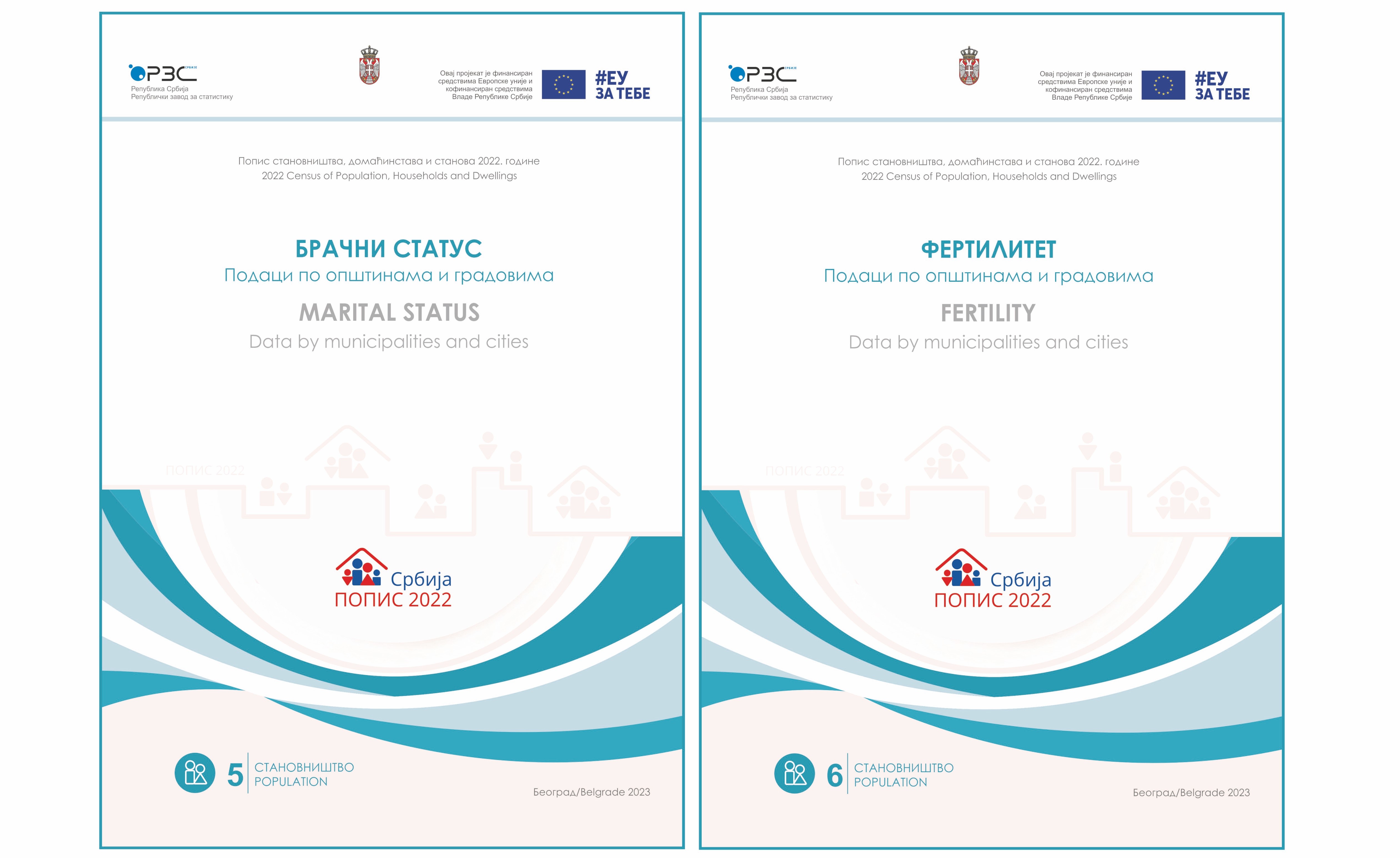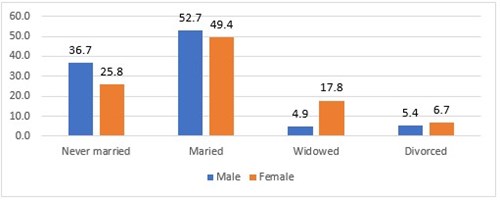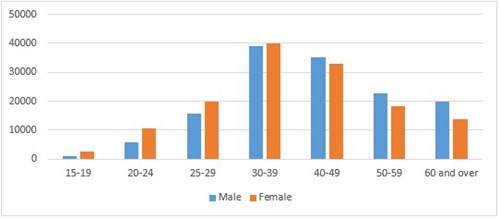
Marital Status and Fertility
Marital Status and Fertility
The Statistical Office of the Republic of Serbia publishes two books with the final results of the 2022 Census of Population, Households and Dwellings:
- Book 5. „Marital Status“ that contains data on the population of the Republic of Serbia aged 15 and over according to the common law martial status, sex and age, and those on the population living in consensual union, by sex and age, by municipalities and cities, and
- Book 6. „Fertility“ that contains data on the population aged 15 and over by number of liveborn children, sex and age, by municipalities and cities.
In addition, the dissemination database contains also the published data on the population aged 15 and by calendar year of birth, sex and marital status, and those on the population aged 15 and over by number of liveborn children, sex, age and ethnic affilitation, by regions.
Marital status
Data on legal marital status
The results of the 2022 Census indicate that about half of the population aged 15 and over are married (51%), almost a third (31%) never married, 11.6% are widowed and 6.1% are divorced persons.
| Total | Male | Female | Total | Male | Female | |
| REPUBLIC OF SERBIA | 5 691 551 | 2 739 739 | 2 951 812 | 100 | 100 | 100 |
| Never married | 1 765 403 | 1 004 774 | 760 629 | 31,02 | 36,67 | 25,77 |
| Married | 2 904 402 | 1 444 770 | 1 459 632 | 51,03 | 52,73 | 49,45 |
| Widowed | 661 418 | 135 397 | 526 021 | 11,62 | 4,94 | 17,82 |
| Divorced | 347 079 | 147 906 | 199 173 | 6,10 | 5,40 | 6,75 |
| Unknown | 13 249 | 6 892 | 6 357 | 0,23 | 0,25 | 0,22 |
Observed by sex, the largest differences are noted in the share of the not married and widowed persons. Namely, 36.7% of men aged 15 and over have never married, while among women aged 15 and over 25.8% have never married. On the other hand, among women aged 15 and over, 17.8% are widowed, while only 4.9% of men in same age group are widowed.

In the period between the two last censuses (2011-2022) the share of married persons decreased – from 55% (2011 Census) to 51% (2022 Census), while the share of not married persons increased – from 28% (2011 Census) to 31% (2022 Census). The share of divorced persons went up by about 1% – from 4.9% (2011 Census) to 6.1% (2022 Census), while the share of the widowed remained unchanged relative to the previous census.
Data by municipalities and cities – 2022 Census
Municipalities with the largest share of married are folloving five: Preševo (60.6%), Bujanovac (59.5%), Аleksandrovac (59.3%), Prijepolje (59.0%) and Raška (58.9%). The largest share of not married persons was noted in the city municipalities of the City of Belgrade – Stari grad (38.4%), Zvezdara (38.0%), Vračar (37.8%), Palilula (37.1%) and Voždovac (36.2%) and in City of Novi Sad (36%), while the share of divorced persons is the largest in Subotica (8.9%), Bečej (8.7%), Senta (8.6%), Zaječar (8.3%) and in the Belgrade municipalities Stari grad (8.3%) and Vračar (8.2%).
Data on persons living in consensual union
The results of the 2022 Census indicate that of the total number of 5 691 551 persons aged 15 and over, 277 140 (4.87%) live with a partner in consensual union. Their average age is 42.38 years.
Observed by sex, there are 138 933 men and 138 207 women who live in consensual union. The age of men in consensual union is, on average, 44 years, and that of women about 41.

In the period between the two last censuses, the share of the persons living in consensual union in the population aged 15 and over increased from 3.83% (2011 Census) to 4.87% (2022 Census).
Data by municipalities and cities – 2022 Census
The largest share of persons living in consensual union in the total population aged 15 and over is noted in: Мајdanpek (10.5%), Kovin and Žagubica (9.5%), Bela Crkva (8.8%), Požarevac (8.7%) and Srbobran (8.5%).
The smallest share of persons living in consensual union is in the municipalities of Preševo, Prijepolje and Trgovište (under 1%), Raška and Mali Zvornik (1.0%) and Sjenica and Ljubovija (1.2%).
Fertility
Data on the number of liveborn children are collected for women in all the censuses over the period 1948–2022. It is in the 2022 Census that men were asked for the first time about the number of liveborn children.
| Number of liveborn children | Republic of Serbia | Male | Female | |||
| Total | % | Total | % | Total | % | |
| Republic of Serbia | 5 691 551 | 100 | 2 739 739 | 100 | 2 951 812 | 100 |
| Without children | 1 760 588 | 30,93 | 1 002 736 | 36,60 | 757 852 | 25,67 |
| 1 child | 1 025 192 | 18,01 | 443 443 | 16,19 | 581 749 | 19,71 |
| 2 | 2 263 716 | 39,77 | 999 430 | 36,48 | 1 264 286 | 42,83 |
| 3 | 491 997 | 8,64 | 224 710 | 8,20 | 267 287 | 9,06 |
| 4 | 99 124 | 1,74 | 45 346 | 1,66 | 53 778 | 1,82 |
| 5 and more children | 37 904 | 0,67 | 16 727 | 0,61 | 21 177 | 0,72 |
| Unknown | 13 030 | 0,23 | 7 347 | 0,27 | 5 683 | 0,19 |
| Average number of liveborn children | 1,35 | 1,24 | 1,44 | |||
The results of the 2022 Census indicate that almost a third of the population aged 15 and over do not have liveborn children (the share of persons without children is 31%), 18% have one child, about 40% have two children, 8.64% have three children and 2.4% have four or more liveborn/biological children.
There are considerable differences in the number of liveborn children among men and women. Among men, the share of persons without children and with two children is almost equal (about 36%), followed by men with one biological child (16.2%) and with three children (8,2%). Among women aged 15 and over the largest share is noted among those who gave birth to two children (42.8%), followed by women who have never given birth (25.7%), women with one child (19.7%) and women with three liveborn children (9.1%).
The share of persons with more than three liveborn children is extremely low in both sexes (2.3% among men and 2.5% among women).
Data on the number of liveborn children by sex and age indicate that the shares of persons who did not participate in reproduction are extremely high in the age groups 15–19 and 20–24 both for men and women, which is expected, especially at the beginning of the fertile period. Difference in the reproductive behavior of men and women are most pronounced in the age groups 25–29 and 30–39. Namely, 37.5% of women aged 25–29 gave birth to at least one child, while among men of the same age group only 19% have children. In the age group 30–39 there are 29% of women without children, while the percentage of men of the same age group without children is 48%. The share of persons without children in the age group 40–49 is 16% among women and 27.3% among men.
| Male | ||||||
| Age | Without children | 1 child | 2 children | 3 children | 4 children | 5 children and more |
| 15–19 | 99,59 | 0,31 | 0,05 | 0,01 | 0,00 | – |
| 20–24 | 95,55 | 3,07 | 0,93 | 0,22 | 0,06 | 0,01 |
| 25–29 | 81,11 | 11,55 | 5,49 | 1,24 | 0,36 | 0,12 |
| 30–39 | 48,07 | 20,45 | 23,24 | 6,21 | 1,31 | 0,43 |
| 40–49 | 27,29 | 19,59 | 38,76 | 11,04 | 2,24 | 0,72 |
| 50–59 | 20,05 | 18,53 | 46,48 | 11,41 | 2,36 | 0,86 |
| 60 and over | 10,02 | 17,81 | 58,16 | 10,79 | 2,08 | 0,87 |
| Female | ||||||
| Age | Without children | 1 child | 2 children | 3 children | 4 children | 5 children and more |
| 15–19 | 98,24 | 1,36 | 0,31 | 0,04 | 0,00 | – |
| 20–24 | 86,90 | 8,41 | 3,38 | 0,90 | 0,27 | 0,06 |
| 25–29 | 62,42 | 19,16 | 13,32 | 3,65 | 1,03 | 0,33 |
| 30–39 | 29,08 | 23,71 | 33,96 | 10,12 | 2,26 | 0,73 |
| 40–49 | 16,11 | 22,56 | 45,49 | 12,27 | 2,53 | 0,86 |
| 50–59 | 12,16 | 20,31 | 52,69 | 11,63 | 2,18 | 0,85 |
| 60 and over | 7,77 | 21,25 | 58,33 | 9,66 | 1,84 | 0,87 |
Data on the number of liveborn children of women aged 50–59 indicate that every eight woman who is out of the fertility period does not participate to reproduction, i.e. 12.2% of women did not give livebirth up to the age of 49. On the other hand, every five men aged 50–59 does not have own biological children, i.e. 20% are without children.
Data by municipalities and cities – 2022 Census
The largest average number of liveborn children is noted in Majdanpek, Tutin, Sjenica, Preševo, Prijepolje, Bojnik and Novi Pazar (more than 1.6 children, on average), while the smallest number of liveborn children is in the city municipalities of the City of Belgrade – Stari grad, Vračar, Savski venac, Zvezdara, Novi Beograd, Voždovac, Palilula, as well as among the population of Novi Sad (less than 1.2 children, on average).
Links:
- 25.09.2024. September 25-27, 2024, Šabac, Workshop "Analysis of the census simulation results based on registers, by municipalities and settlements”.
- 19.07.2024. Daily migrations
- 09.05.2024. Residential Buildings
- 26.04.2024. Households by the family composition and characteristics of the reference person
- 08.03.2024. The most frequent names and surnames
- 23.02.2024. Comparative overview of the number of dwellings
- 23.02.2024. Comparative overview of the number of population and households by censuses 1948–2022
- 28.12.2023. Households and Dwellings on the number of dwellings by type of buildings, year of construction and floor
- 22.12.2023. Population by individual age and by school attendance
- 01.12.2023. Population according to disability status and type of problem of persons with disabilities
- 17.11.2023. Population by economic activity
- 15.11.2023. Heating in occupied dwellings without central heating
- 20.10.2023. Families
- 12.10.2023. Installations in dwellings
- 29.09.2023. Migrations
- 25.08.2023. Marital Status and Fertility
- 24.08.2023. The number of dwellings in the Republic of Serbia according to occupant density, ownership and occupancy status
- 31.07.2023. Educational attainment, literacy and computer literacy
- 20.07.2023. Number of persons and households in dwellings and occupied premises
- 07.07.2023. Households according to the number of members
- 16.06.2023. Мother tongue, religion and ethnic affiliation
- 08.06.2023. Rooms and Auxiliary Premises in Dwelling
- 25.05.2023. Age and Sex
- 18.05.2023. Number and floor space of housing units
- 28.04.2023. Final results - Ethnicity
- 21.12.2022. First results of the 2022 Census of Population, Households and Dwellings
- 21.12.2022. Press conference - The first results of 2022 Census of Population, Households and Dwellings
- 01.12.2022. Tomorrow, December 2, 2022, the enumerators are back on the field
- 08.11.2022. TELEPHONE NUMBERS OF ON-DUTY ENSUMERS BY MUNICIPALITIES AND CITIES
- 07.11.2022. Today, November 7, 2022, at 8 p.m., field data collection in the 2022 Census ends
- 31.10.2022. CENSUS 2022 is entering the final phase of implementation on the ground
- 25.10.2022. Meeting with the High Commissioner on National Minorities of the Organisation for Security and Cooperation
- 21.10.2022. In 20 days, more than 4.7 million citizens have been enumerated in 2022 Census
- 07.10.2022. In six days, more than 1,350,000 inhabitants have been enumerated.
- 30.09.2022. 2022 Census of Population, Households and Dwellings begins
- 26.09.2022. Workshop on Census
- 20.09.2022. Final list of selected enumerators
- 16.09.2022. Census info-center 2022 has started working
- 08.09.2022. Meeting of the representatives of the Embassy of Great Britain
- 01.09.2022. Training of enumerator candidates
- 26.08.2022. Final list of candidates for enumerators invited for training
- 20.08.2022. Preliminary list of candidates for enumerators invited for training
- 18.08.2022. Information workshops for members of national councils of national minorities on the occasion of the upcoming Census
- 12.08.2022. The final list of selected instructors
- 10.08.2022. Ranking list of registered candidates for enumerators
- 08.08.2022. Ranking lists of registered enumerator candidates are published on August 10
- 22.07.2022. Public call for registering enumerators
- 22.07.2022. Final list of instructor candidates invited for training
- 21.07.2022. The final list of candidates for IT assistants who passed the 2nd round of the public call
- 19.07.2022. Media conference on the occasion of 2022 Census of Population, Households and Dwellings in the Republic of Serbia
- 15.07.2022. Announcement of public call for enumerators
- 13.07.2022. Preliminary list of candidates for IT assistants, second round
- 06.07.2022. Ranking list of candidates for instructors in the Census 2022 who are invited to submit documentation, test and interview
- 05.07.2022. List of registered candidates for work as an IT assistant, second round
- 29.06.2022. The second public call for applicants to work as an IT assistant
- 28.06.2022. Final list of candidates for IT assistants
- 24.06.2022. Public call for candidates for instructors in the 2022 Census
- 22.06.2022. Preliminary list of candidates for IT assistants
- 21.06.2022. Training of municipal and regional coordinators
- 17.06.2022. About 2,500 instructors will be needed to conduct the 2022 Census in the Republic of Serbia
- 14.06.2022. List of registered candidates for work as an IT assistant
- 08.04.2021. Field implementation of the Census from October 1st to October 31st, 2022
LATEST NEWS
Share this page |
|
|





